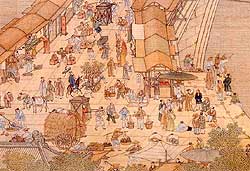Song, Yuan, Ming and Qing Dynasties (960-1911)

The period of the Five Dynasties and Ten States, which succeeded the Tang Dynasty, was one of almost continual warfare. In 960, Zhao Kuangyin, a general of the State of Later Zhou, established the Song Dynasty (960-1279), historically known as the Northern Song Dynasty. When the Song Dynasty moved its capital to the south, historically called the Southern Song Dynasty, it brought advanced economy and culture to the south, giving a great impetus to economic development there China in the Song Dynasty was in the front rank of the world in astronomy, science and technology and printing technology as evidenced, for example, by Bi Sheng’s inventing movable type printing, a great revolution in printing history.
In 1271, Kublai, a grandson of Genghis Khan, conquered the Central Plain, founded the Yuan Dynasty (1271-1368), and made Dadu (today’s Beijing) the capital. Kublai wrote finis to the centuries-long situation in which many independent regimes existed side by side, and formed a united country that brought Xinjiang, Tibet and Yunnan under its sway. During the Song-Yuan period, the “four great inventions” in science and technology of the Chinese people in ancient times—papermaking, printing, the compass and gunpowder—were further developed, and introduced to foreign countries, making great contributions to world civilization.
In 1368, Zhu Yuanzhang established the Ming Dynasty (1368-1644) in Nanjing, reigning as Emperor Taizu. When his son and successor Zhu Di (r. 1360-1424) ascended the throne, in 1360, he built and expanded the palaces, temples, city walls and moat in Beijing on a large scale. In 1421, he officially moved the capital to Beijing. During his reign, he dispatched a eunuch named Zheng He to lead a fleet of many ships to make seven far-ranging voyages. Passing the Southeast Asian countries, the Indian Ocean, Persian Gulf and Maldives Islands, Zheng He explored as far as Somalia and Kenya on the eastern coast of Africa. These were the largest-scale and longest voyages in the world before the age of Columbus.
The Manchus of northeast China established the Qing Dynasty (1644-1911) in 1644, under the leadership of Nurhachi. Kangxi (r. 1661-1722) was the most famous emperor of the Qing Dynasty. He brought Taiwan under Qing rule, and resisted invasions by tsarist Russia. To reinforce the administration of Tibet, he also formulated the rules and regulations on the confirmation of the Tibetan local leaders by the Central Government. He effectively administered over 11 million sq km of Chinese territory.
 0 Comments
0 Comments






